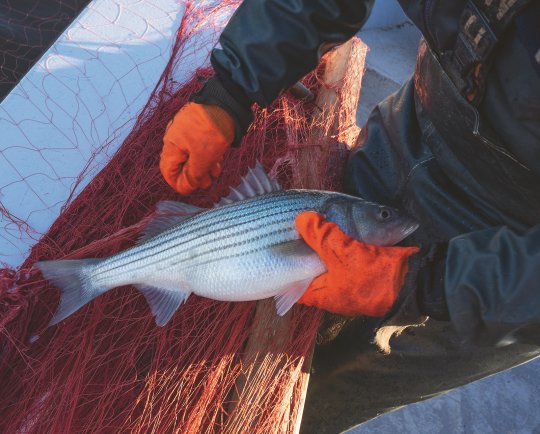 Striped bass are feeling the stress of warmer water in the Chesapeake Bay. (Bay Journal photo by Dave Harp)
Striped bass are feeling the stress of warmer water in the Chesapeake Bay. (Bay Journal photo by Dave Harp)Chesapeake Bay anglers are facing a stark future—a future in which summertime fishing for striped bass, once a hallmark of Bay fishing, may become a distant memory.
A century ago, fishing for striped bass was centered on meals for the table. Then sportfishing boomed in the 1950s, '60s and '70s, with increased incomes, leisure and boat ownership. The public embraced the enthusiasm of Bill Burton, famed angler and Baltimore Sun reporter, for a day on the water.
And with virtually no regulatory limits, they reeled in millions of skillet-size striped bass on halcyon summer days. But summers were much cooler then.
Now, the Maryland Department of Natural Resources posts striped bass heat advisories, warning against taking the fish when air temperatures exceed 90 degrees F—which in 2022 accounted for one-third of the summer. By 2050, climate predictions tell us, the majority of summer days will exceed this threshold.
Most large striped bass, those 30 inches and longer, prefer to spend the summers in cooler waters offshore of New England. But the younger, smaller fish don't generally join them; they stay in the Bay, where they endure ever longer and more extreme heatwaves.
The sunbaked summer water of the Chesapeake permeates muscle and viscera, and doubles heart rates in the fish. This athletic species adjusts, but increased respiration just keeps pace. Until fall cooling, the unrelenting heat drains the fish's capacity to swim, find food, resist disease and recover from stress.
Increased summer heat exacerbates the stresses of fishing and disease. An undersize fish caught on a pleasant June day and dutifully released with the greatest of care—non-offset circle hook, minimum time out of water, dehooking tool, wetted hands and net—will still lose some of its protective slime, allowing a point of attack by the infectious mycobacteria.
High rates of fishing mean that this same fish may be caught repeatedly. When that fish is caught again in July, red infection sores will likely be visible on its flank—and, undersize or not, the unsavory fish is destined to head back into the water.
On board, while the fish are being dehooked, exposure to the hot July air may itself do them in. The fish that do survive being caught and released are now voracious, compelled to recoup physiological losses. Searching for easy meals, they are much more susceptible to being caught yet again. And anglers, with ever-improving sonar, find their targets concentrated in pockets of slightly cooler and better oxygenated waters.
The combination of heat, disease and fishing pressure is a losing battle for resident rockfish. A 2018 Virginia Institute of Marine Science study in the Rappahannock River reported that the combination of these stresses caused nine of 10 fish to perish during the summer.
Regrettably, the only way out of this summertime heat trap is to take striped bass fishing out of the equation.
Fishery managers are heading off the heat with increased restrictions. Summer fisheries (June 15–Oct. 15) have been closed for some time in Virginia. Beginning in 2020, the Potomac River Fisheries Commission closed the season for nearly six weeks (July 6–Aug. 20).
Maryland's Department of Natural Resources was less aggressive, closing it only for the last half of July—though it does ask recreational anglers to reduce fishing pressure on the hottest days. In its Striped Bass Fishing Advisory Forecasts, DNR recommends leaving striped bass in the water when air temperatures exceed 90 degrees F, and not fishing at all in temperatures 95 degrees or higher.
Overlaying summer regulations, managers are struggling with other measures to address overfishing, such as narrowing legal size windows. The Atlantic States Marine Fisheries Commission in early May issued emergency orders for states to reduce the maximum size for keepers to 31 inches.
But make no mistake, as opposed to climate-based restrictions, such measures come and go, and size restrictions do nothing to minimize the damages of catch-and-release during summer months. Climate-based regulations are likely here to stay. Sadly, we forecast a Chesapeake Bay that may no longer support a summer striped bass fishery.
In the meantime, anglers can do their part by voluntarily observing a summer sabbatical for striped bass and shifting their efforts to blue catfish, a most-destructive invasive species that seemingly thrives in the Bay's warming waters.
Dave Secor is a fisheries and environmental scientist at the University of Maryland Center for Environmental Science, Chesapeake Biological Laboratory. Marty Gary is executive secretary of the Potomac River Fisheries Commission and chair of the Atlantic States Marine Fisheries Commission's striped bass management board. Their views do not necessarily reflect those of the Bay Journal. This article first appeared in the July/August 2023 issue of the Bay Journal and was distributed by the Bay Journal News Service.


